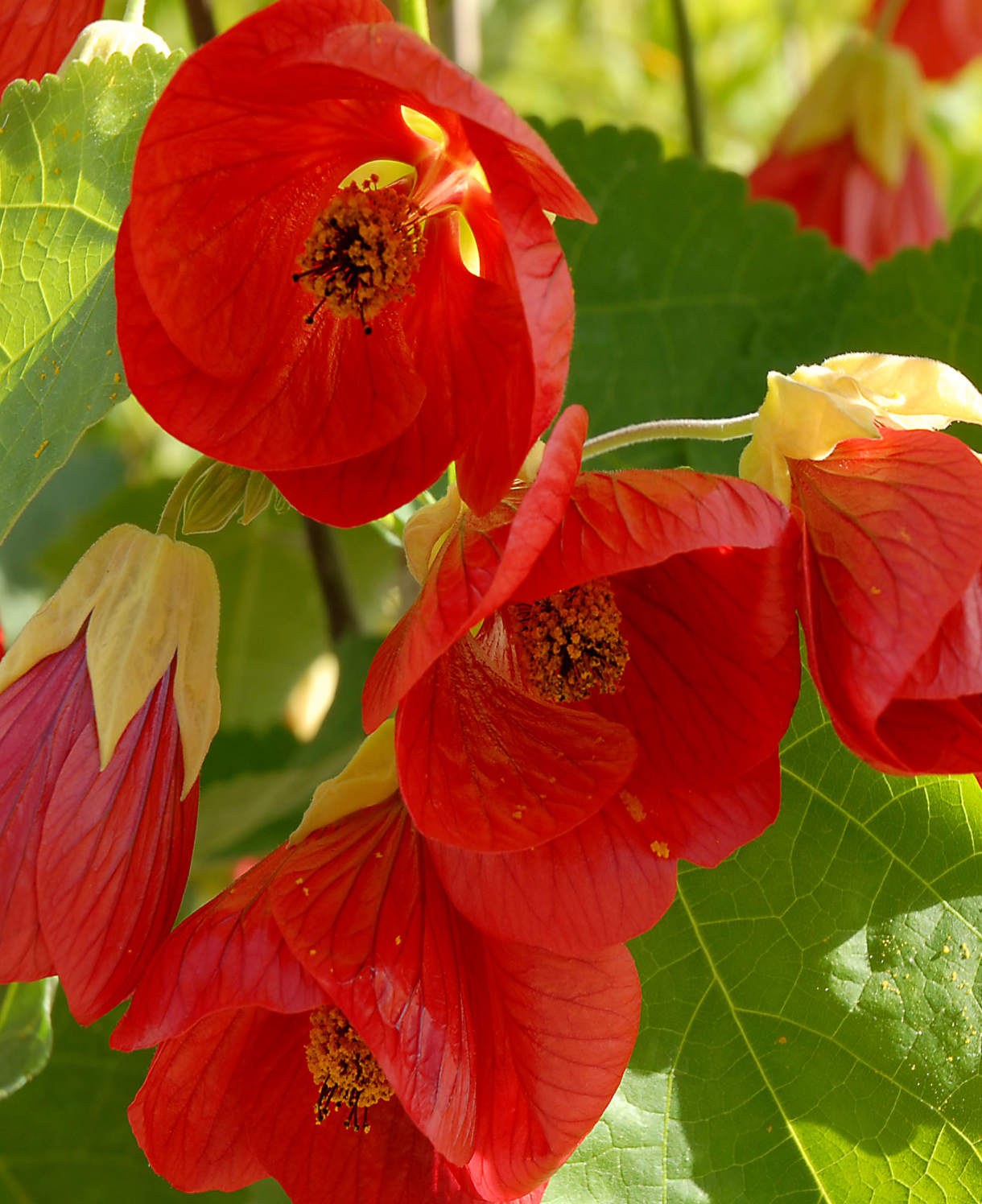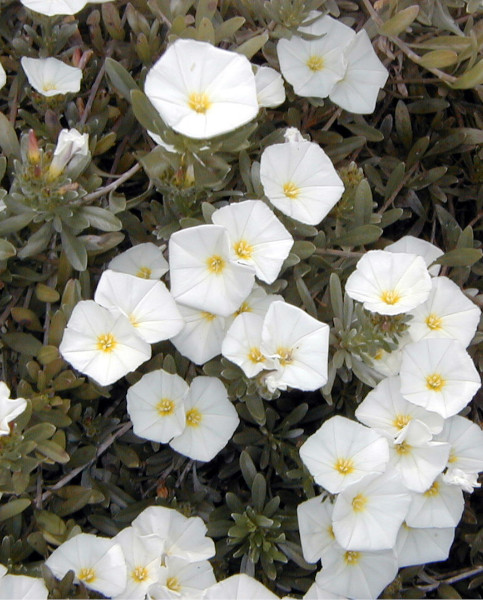How to grow Abutilon
Also known as the Indian mallow or flowering maple, abutilon is an exotic-looking shrub from the subtropical climes of Africa, Asia, Australia, and North and South America. With its profusion of showy yet delicate papery blooms over a long period, abutilon is loved for its impressive appearance yet vigorous and easy nature. Its attractive maple-like leaves tend to be evergreen (or semi-evergreen in cooler temperatures), with many variegated forms available.
Abutilon is best grown as a conservatory or greenhouse plant in all but the mildest microclimates and regions of the UK.

Key Information
Soil pH
Position
Hardiness


Where & when to plant Abutilon
If you live in a coastal or city centre location where temperatures remain mild, your abutilon can be planted outside from late spring onwards. Aim for around late May, and if your plant has arrived before this, keep it in a bright, sheltered environment such as a conservatory, greenhouse, or sunny windowsill or porch. For best results, you’ll need to gradually harden your abutilon off before getting it in the ground, which means acclimatising it to the conditions outside over the course of a week or so. A cold frame is perfect, allowing you to gradually increase the time the lid remains open until eventually leaving it open all night. Alternatively, you can take the following steps:
- First few days: move your plants outside, just during the day at first
- Next few days: leave out all the time, with a fleece covering at night
- Final few days: leave out completely uncovered
Give your abutilon the sunniest, most protected spot you have to offer. Against a warm, south-facing wall is ideal, or in a sunny, sheltered border.
For frost-prone areas (i.e., the majority of the UK), abutilon is best grown in either a conservatory or a cool or temperate greenhouse. Those grown in containers can be moved outside in the warmer months.
How to plant Abutilon
Please note, plants with a trailing or arching habit, such as Abutilon megopotanicum and its cultivars, can be trained against a wall. For this, it is a good idea to install a trellis or wires prior to planting.
- For planting in the garden, dig the soil area removing any large stones and weeds and breaking up any lumps. Mix in some organic matter such as manure or garden compost. Rake level and firm with your heels. Rake level again.
- Water plants well and allow to drain before planting.
- A good tip is to dig a hole twice the size of the root-ball. Fill with water and allow to drain before placing in the plant.
- Place the plant in the hole, ensuring the top of the root ball sits level with the surface of the soil. Too low and the plant may rot, too high and the roots can dry out.
- Backfill with soil and firm in gently with your foot.
- Soak well with water.
- Mulch around the base with well-rotted organic matter.
- If you are training a trailing or arching species against a wall, tie in growth to the supports with garden twine in an evenly spaced manner. If the growth is still too short for this, tie to some angled canes inserted in the soil to direct it in the right direction.
- For planting in containers, first choose an appropriately sized pot. The best practice is to start just a few centimetres larger than the rootball and increase in size every year or two. Always ensure there are plenty of drainage holes in the bottom.
- If you are using a large or heavy pot, it can be a good idea to fill and plant it in situ to save yourself the trouble of moving once full.
- Use a good quality potting compost with plenty of horticultural grit mixed in, and, if not already present in the compost (check the description on the bag) some slow-release fertiliser granules.
- Start by partially filling the pot with compost; enough so that when placed on it the upper surface of the root ball is about 3cm lower than the top of the pot.
- Infill all the space surrounding the root ball with compost, firming down with your fingers then adding a little more so the plant is held tight.
- Pick up the container and lightly tap on the potting bench or ground a few times to help further settle the compost around the plant.
- Soak well with water.
- A mulch with horticultural grit will look attractive and help to prevent a ‘cap’ or crust forming on the top of the compost (something container plants can suffer due to the artificial nature of their watering).
- If you are training a trailing or arching species against a wall, tie in growth to the supports with garden twine in an evenly spaced manner. If the growth is still too short for this, tie to some angled canes inserted in the compost to direct it in the right direction.

What to plant with Abutilon
For a dramatic patio display in summer, contrast the pendulous blooms of your abutilon with erect spikey flowers. Alternatively, create a riot of colour on your patio by partnering your shrub with a neighbouring pot of vivid yellow or orange blooms. As an effective foil to your abutilon’s slender, stretching stems, shrubs with compact bushy growth are a particularly good choice. Geraniums, hydrangeas and roses are often used as companion plants for abutilons.
If you would like any further planting ideas or growing advice for your ‘Abutilon megapotamicum’, please contact our friendly and knowledgeable Customer Care Team - we will be more than happy to help you.



How to care for Abutilon
Pruning and Deadheading
The RHS categorises abutilon as falling into three of its pruning groups (1, 6, and 9). What this slightly vague guidance means is that there are no hard or fast rules. Abutilon can be:
- Left unpruned, simply removing any dead, diseased, damaged, or badly placed growth in late spring (late April to early May).
- Pruned lightly to fit a space, again in late spring.
- Hard pruned, also in late spring, to encourage a more compact and floriferous plant. Cut back to 2-3 buds above ground. The plant should respond with lots of new growth which should bear flowers from August onwards.
Watering
Outside, abutilon should be regularly watered during its first growing season in the ground. After this, it should need watering only in hot, dry weather. Aim to water well and occasionally rather than little or often, as this encourages the formation of a deep, healthy root system. Allowing the top few centimetres of soil to dry out between soakings is a good rule of thumb; to check, wiggle your finger down into the soil until you hit a bit that feels damp.
Container-grown abutilon have less access to moisture (particularly when grown inside) so need regularly watering throughout every growing season. Water freely from March to September; sparingly in winter (just enough to keep the soil barely moist).
Feeding
On healthy, fertile soil, an annual mulch of well-rotted organic matter (i.e., a layer of manure or garden compost applied to the soil around the plant) should provide sufficient nutrients for your outdoor-grown abutilon. This has the added benefit of suppressing weeds and locking in moisture and is best done in autumn or spring.
If your plant looks in need of an extra boost or you garden on poor soil, applying a general purpose granular feed to the surface of the soil and lightly working in (known as a ‘top dress’) can reap benefits. Aim to do this in spring.
Container-grown abutilon rely more on the gardener for nutrition. Get off to a flying start by making sure you use a good quality compost, then throughout the growing season (March to September) apply a liquid feed every two to four weeks. For plants that have been in their container for a couple of years or more, a top dress is also advisable. In spring, scrape off the top 5cm of compost and replace with fresh compost containing a general purpose granular feed.
Cold Protection
All our abutilon are half-hardy, meaning they are unable to withstand a UK winter outside in all but the mildest of microclimates and areas. In most cases it is advisable to overwinter in a covered environment such as a conservatory or greenhouse.
Those in a location where temperatures remain mild can grow abutilon outside in a warm, sheltered spot, though even in these circumstances you should brace yourself for the occasional winter loss.
Pests and Diseases
Outdoors, abutilon tends to be problem-free, though in glasshouses or conservatories the usual issues of spider mite and aphid can crop up. Keeping plants as healthy as possible is the key to warding off problems, and by this we mean proper ventilation, adequately spaced plants (for good air flow), keeping everything well-watered and fed, and repotting into larger containers when necessary. Thoroughly cleaning the indoor environment every winter can also help to remove overwintering populations of pests.
Where infestations do take hold, try introducing biological controls (often sachets or tubes containing miniscule natural predators), or in the worst cases, remove the affected plant/s altogether.
How to propagate Abutilon
Abutilon is best propagated by cuttings taken in summer.
- Find non-flowering shoots 5-10cm long and snip off the plant.
- Put them in a plastic bag straight away to prevent drying out.
- Fill a container with a compost mix which is at least 50% perlite (or if you prefer, as we do, 100% perlite).
- Remove the lowest third of leaves. If the remaining leaves are large, cut them in half (to reduce water lost through transpiration).
- Insert the cuttings into the compost and water lightly. Several cuttings can be put in the same container if there is enough space to do this without them touching.
- Place in a propagating unit with bottom heat if you have one or covered with a plastic bag on a windowsill if not (out of direct sunlight).
- Keep the cuttings misted and occasionally watered until they root. You will know this has happened when roots emerge out of the bottom of the container.
- Gently remove rooted cuttings and pot them into individual pots. Grow on in an unheated conservatory or greenhouse they are big enough to be planted out.
* Many plants carry Plant Breeders Rights and cannot be propagated for commercial purposes.
Common Abutilon questions
Is abutilon hardy?
While some species may tolerate temperatures up to -5°C, others will struggle much below 1°C. As a general rule, abutilon is only winter hardy in mild coastal areas or in the shelter and warmth of a city garden. Everywhere else, overwinter in a protected environment.
Is abutilon a perennial?
This depends on the species. In UK gardens shrubby species are the most common, meaning they have a permanent woody framework and can live for many years. The foliage can be evergreen, semi-evergreen, or deciduous.
Can you grow abutilon indoors?
Absolutely, and in fact has been a popular indoor plant since its Victorian and Edwardian heyday.




